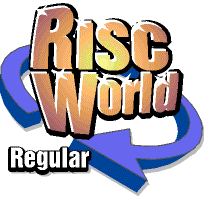



StarPROG
Lawrence Granville re-opens an old favourite.
Do you remember a long running series in Acorn User. It was called StarInfo and featured home grown graphical ditties from readers. Well I used to buy Acorn User just for StarInfo, and every time I got my hands on a cover disk the first place I went was StarInfo. So with the Editors permission (and some trepidation - ED) I propose that RISC World should start up a similar series.
What we want
Simply put we want to publish any interesting small pieces of software written by our readers. We will pay £10 for each one we use. You would still keep the copyright, but we would have non exclusive distribution rights. That means we could use it again on a future compilation CD, but by the same token you could still place the program on your website and give it to others.
If you have anything you think we might like then e-mail us at starprog@riscworld.co.uk and if we think others will enjoy it we will use it!
Kicking off
Since we have no reader submissions this month we will kick of with some little programs written by the RISC World editorial staff.
SloBARC
SloBARC stands for Slow BAsic RayCaster. SloBarc is a 1 line BASIC maze generator and depth shaded ray caster, there that didn't hurt did it? If you want to know what a ray caster is then try playing any of the modern 3D games such as DOOM, Destiny or Quake. A simple 2D maze is constructed, this is then projected up to produce a 3D image using the Ray Caster. This works in a similar way to a ray tracer, light rays are sent out from the users viewpoint until they hit an object, a ray tracer sends light into the users viewpoint from objects. The further the light ray travels before hitting the object the further the object is away and the darker its colour (this is the depth shading). Light is only sent out in two dimensions, SloBARC has no concept of height, the apparent height of objects is calculated from their distance away from the viewer.
SloBarc comes in several different flavours.
- SloBRCarm3 - will run on pre RiscPC computers but needs an Arm3 to go at speed.
- SloBRCsa - requires a StrongARM Risc PC in order to work
- SloBRCdeep - also needs a StrongARM - looks further into maze at lower accuracy
- SloBRC2100 - runs on a StrongARM slowly as it is at much higher quality.
Stars
Here is the old favourite the multi parallax star field. This simply draws a load of dots and moves them so they look like stars. The program is really very simple, a piece of memory is claimed with a DIM command, and filled with sets of X and Y co-ordinates. A little loop then draws a pixel at each co-ordinate then decreases the X co-ordinate a bit. Next time the star is drawn it moves slightly to the left. Two screen banks are used to prevent flicker.
Stars comes in two versions.
- ARM3 - will move 135 stars every frame.
- StrongARM - moves a massive 1500 stars every frame.
WarpSpeed
And finally something our editor started a few years ago and didn't finish properly, !WarpSpeed. This needs a StrongARM and at least 1024K of screen memory in order to work correctly.
WarpSpeed is quite interesting as it is written as a library that can be re-used, so you could quite easily take WarpSpeed apart and make your own demo put of the routines (provided you know a little bit about BASIC programming of course). For once Aaron has even managed to put comments explaining what each routine does (I always do - ED). In fact it might be interesting to see what readers could make of the WarpSpeed library, fancy having a go?
That is it for this issue, if you want StarPROG to continue then send in your contributions!
Lawrence Granville